Sword 1/72 Harrier T.2/TAV-8A Harrier
| KIT #: | SW 72061 |
| PRICE: | $36.99 SRP |
| DECALS: | Three options |
| REVIEWER: | Scott Van Aken |
| NOTES: | New tool kit |
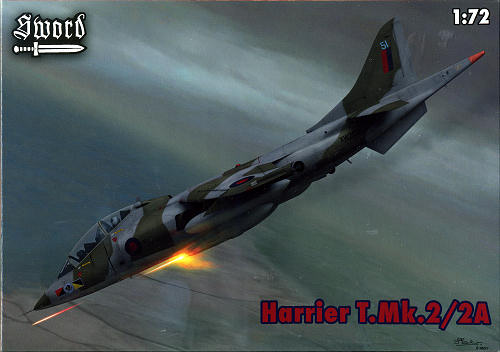
The Hawker Siddeley Harrier, known colloquially as the "Harrier Jump Jet", was developed in the 1960s and formed the first generation of the Harrier series of aircraft. It was the first operational close-support and reconnaissance fighter aircraft with vertical/short takeoff and landing (V/STOL) capabilities and the only truly successful V/STOL design of the many that arose in that era. The Harrier was produced directly from the Hawker Siddeley Kestrel prototypes following the cancellation of a more advanced supersonic aircraft, the Hawker Siddeley P.1154. The Royal Air Force (RAF) ordered the Harrier GR.1 and GR.3 variants in the late 1960s. It was exported to the United States as the AV-8A, for use by the US Marine Corps (USMC), in the 1970s.
While the USMC operated improved TAV-8Bs for the AV-8B, the RAF continued to upgrade their Harrier T.2s for use even when the later Harrier and Sea Harrier variants came into use. These airframes were used throughout the Harrier program until the very end.
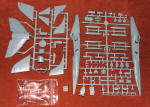 Sword has been doing short run kits for quite a while and seemingly improving all the time. This is one of the nicest they have yet produced. How can one tell a short run kit? Well, the first give-away is the lack of alignment pins. You will also find ejector towers in the larger parts. These sorts of kits will generally rely on resin, photo-etch or both to provide very small details. They are also generally not large and if so, the fuselages and wings will be in several segments to fit into the smaller molding machines.
Sword has been doing short run kits for quite a while and seemingly improving all the time. This is one of the nicest they have yet produced. How can one tell a short run kit? Well, the first give-away is the lack of alignment pins. You will also find ejector towers in the larger parts. These sorts of kits will generally rely on resin, photo-etch or both to provide very small details. They are also generally not large and if so, the fuselages and wings will be in several segments to fit into the smaller molding machines.
This Sword Harrier T.2 is not the only two seat Harrier ever injection molded. Heller did one of their snap kits of the T.4 many years back. Being a snap kit, it was a decent basic outline, but lacking in detail. Not so this Sword kit. Thanks to a color photo etch fret, there is oodles of small details. Most of these small bits are for the canopy, interior or the myriad of antennas that these planes carry. I would guess the fret is done by Eduard, but that is only a guess. Like some earlier injected Harriers, the exhaust nozzles on this one are a single casting. This is something I prefer as it eliminates what is often a troublesome seam, though detail may be a bit shallower because of it.
T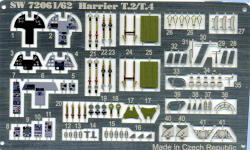 he kit also has a single piece of resin. This is for the speed brake well. Finding this well open on the ground was not uncommon and so you now have a nicely detailed one. Backtracking a bit to the cockpit. This kit supplies the front and rear one separately. It is here that the lion's share of p.e. will find a use. This includes all the straps and belts for the bang seats. One then assembles the nose gear well and inserts this and the other wells into the fuselage before closing it. Each wing is a single upper piece with two lower sections. You have no fewer that three fins on this kit, but you will only need one. There are other boxings of this one. As this is the first two seater from the 70s, it will have the small pointed nose cone. The later nose of the T.4 is included as well so if you have the markings, you can do one of those. Harriers, like Hunters, were frequently rebuilt to later standards and with later serials.
he kit also has a single piece of resin. This is for the speed brake well. Finding this well open on the ground was not uncommon and so you now have a nicely detailed one. Backtracking a bit to the cockpit. This kit supplies the front and rear one separately. It is here that the lion's share of p.e. will find a use. This includes all the straps and belts for the bang seats. One then assembles the nose gear well and inserts this and the other wells into the fuselage before closing it. Each wing is a single upper piece with two lower sections. You have no fewer that three fins on this kit, but you will only need one. There are other boxings of this one. As this is the first two seater from the 70s, it will have the small pointed nose cone. The later nose of the T.4 is included as well so if you have the markings, you can do one of those. Harriers, like Hunters, were frequently rebuilt to later standards and with later serials.
For weapons you get two under fuselage 25mm cannon housings. You can also install the strakes that were put in place when the cannon were not carried. For under the wings, you get a pair of fuel tanks. No under wing weapons are provided, but since this was a trainer, you would rarely find anything there. In fact, it was not unusual to find not all the pylons installed so check photos for your subject. In closing the description, I'll mention the canopy is in three pieces with a separate windscreen, student and instructor canopy. A blast shield is also included.
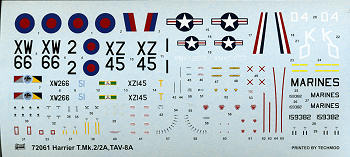 There are three markings options, all in pretty much the same color scheme of Dark Green and Dark Sea Grey over Light A
There are three markings options, all in pretty much the same color scheme of Dark Green and Dark Sea Grey over Light A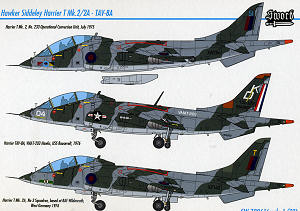 ircraft Grey. I believe these were initially glossy but later a more matte color. The demarcation lines were pretty tight. The various radome panels are in a dark tan, though these did tend to fade with time. For the RAF, you have a plane from 233 OCU in July 1975 and one with 3 Squadron in 1976. The 233 OCU has the original short fin. The TAV-8A is with VMAT-203 in 1976. While the box work says it was assigned to the USS FDR, that is not on the aircraft and this ship was only used for sea trials for students. Decals are superbly printed and include the bevy of data markings. In fact, the instructions devote two pages to data placement.
ircraft Grey. I believe these were initially glossy but later a more matte color. The demarcation lines were pretty tight. The various radome panels are in a dark tan, though these did tend to fade with time. For the RAF, you have a plane from 233 OCU in July 1975 and one with 3 Squadron in 1976. The 233 OCU has the original short fin. The TAV-8A is with VMAT-203 in 1976. While the box work says it was assigned to the USS FDR, that is not on the aircraft and this ship was only used for sea trials for students. Decals are superbly printed and include the bevy of data markings. In fact, the instructions devote two pages to data placement.
If you have been wanting a two seat early Harrier, your wait is over. This one will take a bit of work, as do all short run kits, but the end result will be most pleasing and look great on your display shelf.
http://en.wikipedia.org/wiki/AV-8A_Harrier
2012Thanks to Squadron Products for the preview kit. Get yours today at your local retailer or have them order it for you.
If you would like your product reviewed fairly and fairly quickly, please contact the editor or see other details in the Note toContributors.
Back to the Main Page
Back to the Previews Index Page



 he kit also has a single piece of resin. This is for the speed brake well. Finding this well open on the ground was not uncommon and so you now have a nicely detailed one. Backtracking a bit to the cockpit. This kit supplies the front and rear one separately. It is here that the lion's share of p.e. will find a use. This includes all the straps and belts for the bang seats. One then assembles the nose gear well and inserts this and the other wells into the fuselage before closing it. Each wing is a single upper piece with two lower sections. You have no fewer that three fins on this kit, but you will only need one. There are other boxings of this one. As this is the first two seater from the 70s, it will have the small pointed nose cone. The later nose of the T.4 is included as well so if you have the markings, you can do one of those. Harriers, like Hunters, were frequently rebuilt to later standards and with later serials.
he kit also has a single piece of resin. This is for the speed brake well. Finding this well open on the ground was not uncommon and so you now have a nicely detailed one. Backtracking a bit to the cockpit. This kit supplies the front and rear one separately. It is here that the lion's share of p.e. will find a use. This includes all the straps and belts for the bang seats. One then assembles the nose gear well and inserts this and the other wells into the fuselage before closing it. Each wing is a single upper piece with two lower sections. You have no fewer that three fins on this kit, but you will only need one. There are other boxings of this one. As this is the first two seater from the 70s, it will have the small pointed nose cone. The later nose of the T.4 is included as well so if you have the markings, you can do one of those. Harriers, like Hunters, were frequently rebuilt to later standards and with later serials.  There are three markings options, all in pretty much the same color scheme of Dark Green and Dark Sea Grey over Light A
There are three markings options, all in pretty much the same color scheme of Dark Green and Dark Sea Grey over Light A